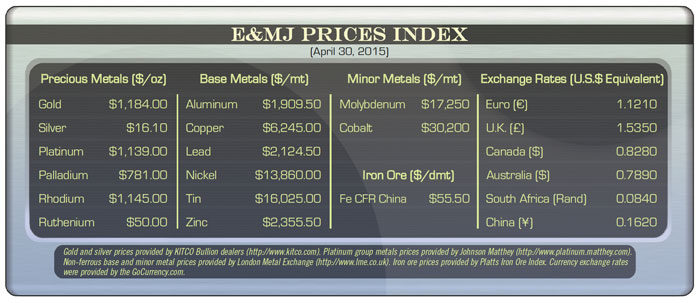The authors of Gold Focus 2015, an annual report that contains comprehensive historical supply and demand statistics and a detailed forecast for 2015, believe that gold will continue to face challenges in the near-term, in particular the global macroeconomic backdrop remaining unfriendly toward the metal.
The biggest headwind continues to be expectations of U.S. interest rate increases later this year, as other developed economies’ ultra-loose monetary policies (notably the Eurozone’s) remain in place. This drives up the dollar against other currencies.
Low inflation, weak commodity prices and strong equities are other factors that should keep gold under pressure.
Price Weakness
All of this points to further price weakness in the coming months and a low of below $1,100/oz. However, there are good arguments to suggest that 2015 may well see the end of the gold bear market. While Western investor interest in gold remains low, selling pressure is likely to ease further from the already much-reduced level of liquidations seen in 2014.
Meanwhile, Asian investment demand for physical gold is expected to recover from last year’s slump. Taken together, this points to stable or even improved investment demand for gold this year compared to 2014.
Other supply/demand factors should also at least mitigate the pressure on the gold price. Albeit marginal, a decline forecast for mine production this year does suggest that the tremendous growth in output seen over the past two decades has probably come to an end.
Meanwhile, producer hedging should remain slight and recycling is expected to remain flat, at levels far lower than those seen a few years ago.
Moving to demand, jewelry consumption is forecast to increase, fueled by growth in Asian markets. Official sector activity will also lend support to gold, as net purchases are expected to remain at near record levels.
Limited Downside
Taking all this into account, they expect the price downside to be limited. Metals Focus forecasts see a low for the year at $1,080/oz and an annual average of $1,190/oz, marking a 6% decline compared to last year. In other currencies, by contrast, prices may well increase over the course of the year, just as they did in 2014, for example in the case of euro gold.
Finally, the authors believe that the actual start of U.S. interest rate increases will, paradoxically, temper the pressure that their expectations have been placing on gold. This is premised on the assumption that increases will be slow and modest, leaving real short-term rates in negative territory for some time to come.
The U.S. economy remains highly dependent on private consumption, while household debt levels in the country are still very high, at least in absolute terms. As such, a dramatic increase in the debt-service ratio could jeopardize the country’s recovery. They expect the Fed to take a measured approach in moving back toward a more normalized policy, particularly given limited inflationary pressures.
End of Bear Market?
They remain cautious towards the prospects of the dollar gold price this year, and believe 2015 is likely to mark the end of the bear market. The last few months of the year may see a modest recovery, with more meaningful gains likely in 2016.
From this point onwards, there are several factors that may provide the spark for a renewed gold bull market. These include gold-positive developments in foreign exchange, debt, inflation, commodity and equity markets.
To request a copy of the 2015 Gold Focus, contact Charles de Meester, sales director: +44 (0) 7809 125 334.










